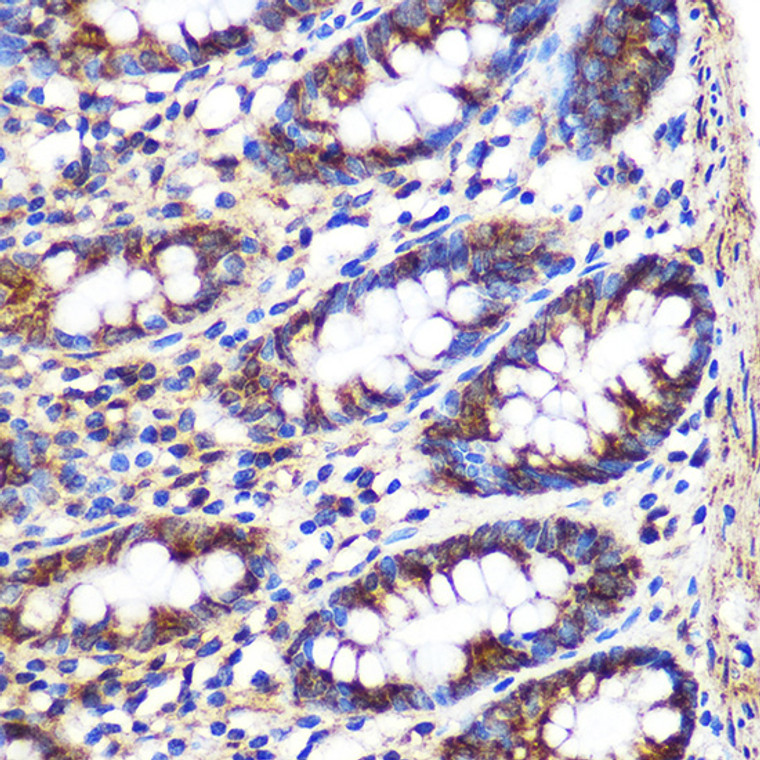| Host: | Rabbit |
| Applications: | WB/IHC/IF |
| Reactivity: | Human/Mouse/Rat |
| Note: | STRICTLY FOR FURTHER SCIENTIFIC RESEARCH USE ONLY (RUO). MUST NOT TO BE USED IN DIAGNOSTIC OR THERAPEUTIC APPLICATIONS. |
| Short Description: | Rabbit polyclonal antibody anti-FGF2 (143-288) is suitable for use in Western Blot, Immunohistochemistry and Immunofluorescence research applications. |
| Clonality: | Polyclonal |
| Conjugation: | Unconjugated |
| Isotype: | IgG |
| Formulation: | PBS with 0.02% Sodium Azide, 50% Glycerol, pH7.3. |
| Purification: | Affinity purification |
| Dilution Range: | WB 1:500-1:1000IHC-P 1:50-1:200IF/ICC 1:50-1:200 |
| Storage Instruction: | Store at-20°C for up to 1 year from the date of receipt, and avoid repeat freeze-thaw cycles. |
| Gene Symbol: | FGF2 |
| Gene ID: | 2247 |
| Uniprot ID: | FGF2_HUMAN |
| Immunogen Region: | 143-288 |
| Immunogen: | Recombinant fusion protein containing a sequence corresponding to amino acids 143-288 of human FGF2 (NP_001997.5). |
| Immunogen Sequence: | PALPEDGGSGAFPPGHFKDP KRLYCKNGGFFLRIHPDGRV DGVREKSDPHIKLQLQAEER GVVSIKGVCANRYLAMKEDG RLLASKCVTDECFFFERLES NNYNTYRSRKYTSWYVALKR TGQYKLGSKTGPGQKAILFL PMSAKS |
| Tissue Specificity | Expressed in granulosa and cumulus cells. Expressed in hepatocellular carcinoma cells, but not in non-cancerous liver tissue. |
| Post Translational Modifications | Phosphorylation at Tyr-215 regulates FGF2 unconventional secretion. Several N-termini starting at positions 94, 125, 126, 132, 143 and 162 have been identified by direct sequencing. |
| Function | Acts as a ligand for FGFR1, FGFR2, FGFR3 and FGFR4. Also acts as an integrin ligand which is required for FGF2 signaling. Binds to integrin ITGAV:ITGB3. Plays an important role in the regulation of cell survival, cell division, cell differentiation and cell migration. Functions as a potent mitogen in vitro. Can induce angiogenesis. Mediates phosphorylation of ERK1/2 and thereby promotes retinal lens fiber differentiation. |
| Protein Name | Fibroblast Growth Factor 2Fgf-2Basic Fibroblast Growth FactorBfgfHeparin-Binding Growth Factor 2Hbgf-2 |
| Database Links | Reactome: R-HSA-109704Reactome: R-HSA-1257604Reactome: R-HSA-1839122Reactome: R-HSA-1839130Reactome: R-HSA-190322Reactome: R-HSA-190370Reactome: R-HSA-190372Reactome: R-HSA-190373Reactome: R-HSA-190375Reactome: R-HSA-190377Reactome: R-HSA-2033519Reactome: R-HSA-2219530Reactome: R-HSA-2892247Reactome: R-HSA-3000170Reactome: R-HSA-3000171Reactome: R-HSA-5654219Reactome: R-HSA-5654221Reactome: R-HSA-5654227Reactome: R-HSA-5654228Reactome: R-HSA-5654687Reactome: R-HSA-5654688Reactome: R-HSA-5654689Reactome: R-HSA-5654693Reactome: R-HSA-5654695Reactome: R-HSA-5654699Reactome: R-HSA-5654700Reactome: R-HSA-5654704Reactome: R-HSA-5654706Reactome: R-HSA-5654710Reactome: R-HSA-5654712Reactome: R-HSA-5654719Reactome: R-HSA-5654720Reactome: R-HSA-5654726Reactome: R-HSA-5654727Reactome: R-HSA-5654732Reactome: R-HSA-5654733Reactome: R-HSA-5655253Reactome: R-HSA-5655302Reactome: R-HSA-5655332Reactome: R-HSA-5658623Reactome: R-HSA-5673001Reactome: R-HSA-6785807Reactome: R-HSA-6811558Reactome: R-HSA-8851708Reactome: R-HSA-9761174 |
| Cellular Localisation | SecretedNucleusExported From Cells By An Endoplasmic Reticulum (Er)/Golgi-Independent MechanismUnconventional Secretion Of Fgf2 Occurs By Direct Translocation Across The Plasma MembraneBinding Of Exogenous Fgf2 To Fgfr Facilitates Endocytosis Followed By Translocation Of Fgf2 Across Endosomal Membrane Into The CytosolNuclear Import From The Cytosol Requires The Classical Nuclear Import MachineryInvolving Proteins Kpna1 And Kpnb1As Well As Cep57 |
| Alternative Antibody Names | Anti-Fibroblast Growth Factor 2 antibodyAnti-Fgf-2 antibodyAnti-Basic Fibroblast Growth Factor antibodyAnti-Bfgf antibodyAnti-Heparin-Binding Growth Factor 2 antibodyAnti-Hbgf-2 antibodyAnti-FGF2 antibodyAnti-FGFB antibody |
Information sourced from Uniprot.org
12 months for antibodies. 6 months for ELISA Kits. Please see website T&Cs for further guidance














